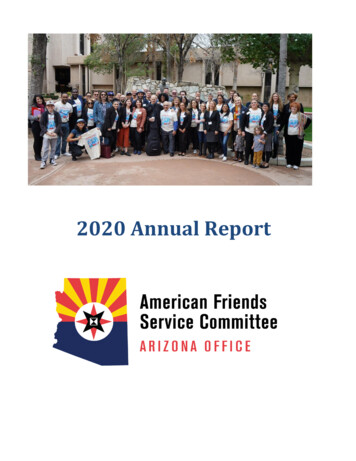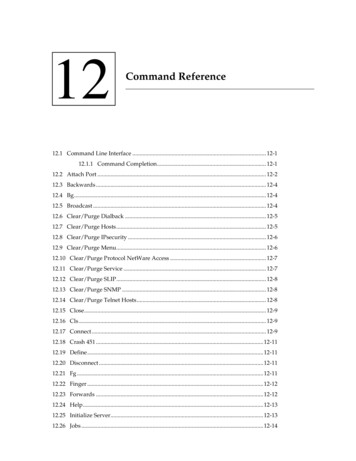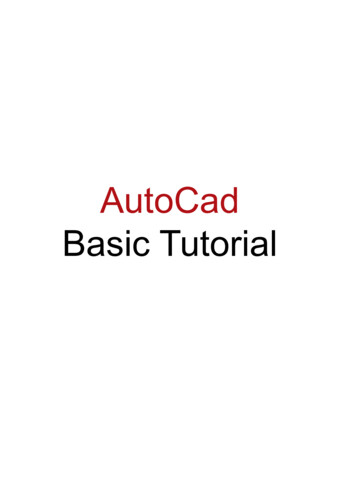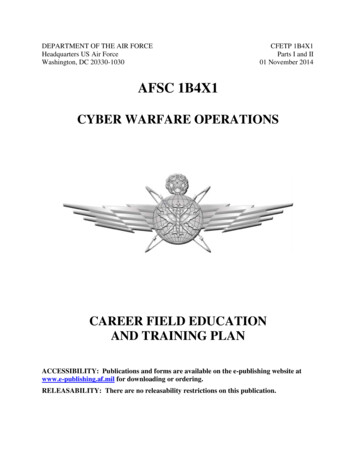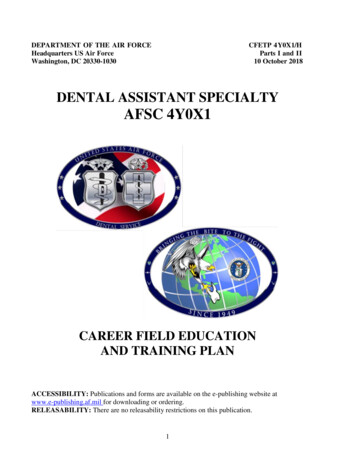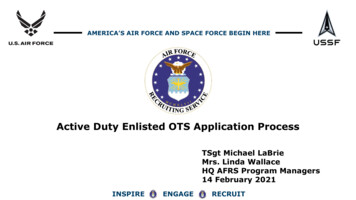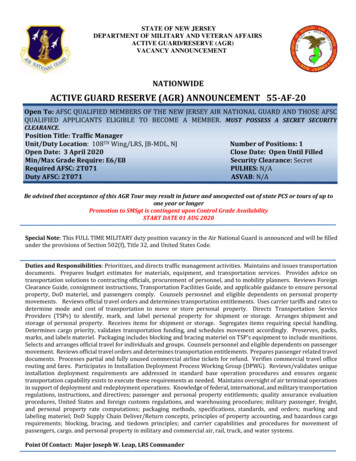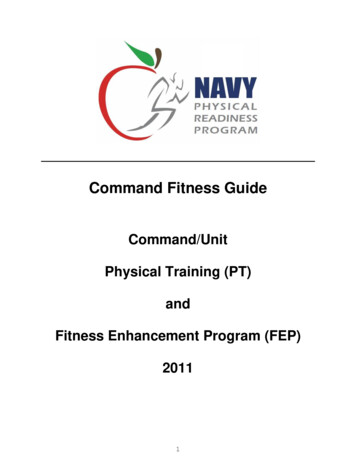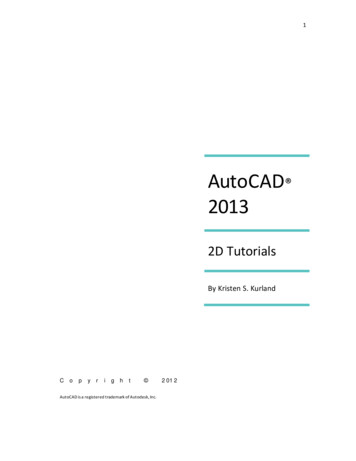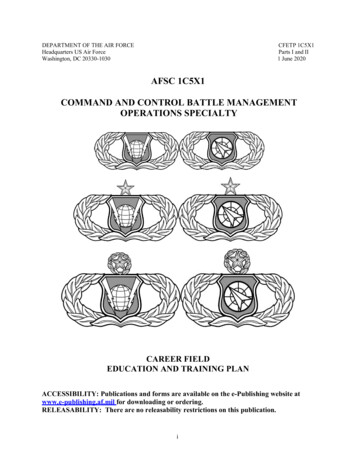
Transcription
DEPARTMENT OF THE AIR FORCEHeadquarters US Air ForceWashington, DC 20330-1030CFETP 1C5X1Parts I and II1 June 2020AFSC 1C5X1COMMAND AND CONTROL BATTLE MANAGEMENTOPERATIONS SPECIALTYCAREER FIELDEDUCATION AND TRAINING PLANACCESSIBILITY: Publications and forms are available on the e-Publishing website atwww.e-publishing.af.mil for downloading or ordering.RELEASABILITY: There are no releasability restrictions on this publication.i
COMMAND AND CONTROL BATTLE MANAGEMENT OPERATIONS SPECIALTYAFSC 1C5X1TABLE OF CONTENTSPrefaceAbbreviations and Terms Explained34PART 1Section A – General InformationPurpose of CFETPUse of CFETPCoordination and Approval of the CFETP6Section B – Career Field Progression and InformationSpecialty DescriptionsSkill/Career ProgressionApprentice Level (3)Journeyman Level (5)Craftsman Level (7)Superintendent Level (9)Training DecisionsCommunity College of the Air Force8Section C – Skill Level Training RequirementsPurposeTraining RequirementsApprentice Level (3)Journeyman Level (5)Craftsman Level (7)Superintendent Level (9)14Section D – Resource Constraints16PART IISection A – Specialty Training Standard17Section B – Course Objective List18Section C – Support Materials18Section D – Training Course Index18Section E – MAJCOM Unique Requirements19AttachmentsAttachment 1 – Qualitative Requirements (Proficiency Code Key)Attachment 2 – 1C5X1 Specialty Training Standard2223OPR: 334TRS/TRRApproved by: Mr. Steven A. Ruehl (HQ USAF/A3T)Supersedes: CFETP 1C5X1, Dated 20 September 2016CFETP 1C5X1 Change 1, Dated 27 January 2017CFETP 1C5X1 Change 2, Dated 28 March 2017Number of Pages: 26ii
COMMAND AND CONTROL BATTLE MANAGEMENT OPERATIONSAFSC 1C5X1CAREER FIELD EDUCATION AND TRAINING PLANPREFACE1. This Career Field Education and Training Plan (CFETP) is a comprehensive education and training documentthat identifies life-cycle education and training requirements, training support resources, and minimum core taskrequirements for this specialty. The CFETP provides personnel a clear career path to success and instills rigor inall aspects of career field training.2. The CFETP consists of two parts; supervisors plan, manage, and control training within the specialty usingboth parts of the plan.2.1. Part I provides information necessary for overall management of the specialty. Section A explains howindividuals will use the plan; Section B identifies career field progression information, duties and responsibilities,training strategies, and career field path; Section C associates each level with specialty qualifications (knowledge,education, experience, training, and other); and Section D indicates resource constraints. Some examples arefunds, manpower, equipment, facilities; Section E identifies transition training guide requirements for SSgtthrough MSgt.2.2. Part II includes the following: Section A identifies the Specialty Training Standard (STS) and includes duties,tasks, Technical References to support training, Air Education and Training Command (AETC) conducted training,wartime course and core tasks and correspondence course requirements; Section B: contains the Course ObjectiveList and training standards supervisors use to determine if Airmen satisfied training requirements. Section C:identifies available support materials. An example is a Qualification Training Package (QTP) which may bedeveloped to support proficiency training. Section D: identifies a training course index supervisors can use todetermine resources available to support training. Included here are both mandatory and optional courses. SectionE: identifies Major Command (MAJCOM) unique training requirements supervisors can use to determine additionaltraining required for the associated qualification needs. At unit level, supervisors and trainers use Part II to identify,plan, and conduct training commensurate with the overall goals of this plan.3. Using guidance provided in this CFETP ensures individuals in AFSC 1C5X1 receive effective and efficienttraining at the appropriate points in their career. This plan enables us to train today’s work force for tomorrow’sjobs.3
ABBREVIATIONS/TERMS EXPLAINEDAdvanced Training (AT). Formal course that provides individuals who are qualified in one or more positions oftheir Air Force Specialty (AFS) with additional skills and knowledge to enhance their expertise in the career field.Training is for selected career Airmen at the advanced level of the AFS.Air Force Career Field Manager (AFCFM). Representative appointed by the respective HQ USAF Deputy Chiefof Staff or Under Secretariat, to ensure assigned AF specialties are trained and utilized to support AF missionrequirements. AF Career Field Manager is the OPR; however, works in concert with MAJCOM Functional Managersas required.Air Force Enlisted Classification Directory (AFECD). The official guide to the Air Force Enlisted Classificationcodes, job specialty, and qualifications necessary to perform each job. This guide establishes the occupationalstructure of the Air Force enlisted force.Air Force Job Qualification Standard/Command Job Qualification Standard (CJQS). AFCFMs issue AF JobQualification Standards for unique duty positions, weapons systems or equipment. The AF Job QualificationStandard supplements the CFETP, Part II, by outlining specific skill and task requirements. AFCFM must reviewand approve any MAJCOM Job Qualification Standard. Use of AF Job Qualification Standards should be limited tothe absolute minimum to reduce duplicate documentation.Air Force Training Record (AFTR). Electronic training data base which provides the capability to manage thetraining lifecycle for Total Force personnel. AFTR may be accessed within the Advanced Distributed LearningService (ADLS) web at https://golearn.adls.af.mil.Career Field Education and Training Plan (CFETP). A comprehensive core training document that identifies:life-cycle education and training requirements; training support resources; and minimum core task requirements fora specialty. The CFETP aims to give personnel a clear path and instill a sense of industry in career field training.Combat Mission Ready (CMR). A Command and Control Battle Management Operations member who hassatisfactorily completed initial qualification training and mission qualification training and maintains qualificationand proficiency in the command or unit operational mission.Continuation Training (CT). Additional training exceeding requirements with emphasis on present or future dutyassignments.Core Task. Tasks the AFCFM identify as minimum qualification requirements for everyone within an AFSC,regardless of duty position. Core tasks may be specified for a particular skill level or in general across the AFSC.Guidance for using core tasks can be found in the applicable CFETP narrative.Field Training. Technical, operator, and other training either a training detachment or field training team conductsat operational locations on specific systems and associated direct-support equipment.Initial Skills Training. A formal school course that results in an AFSC 3-skill level award for enlisted.Occupational Survey Report (OSR). A detailed report that shows the results of an occupational survey of tasksperformed within a particular AFS.On-the-Job Training (OJT). Hands-on, “over-the-shoulder” training or evaluation conducted to certify personnel inboth upgrade (skill level award) and job qualification (position certification training).Position Qualification Training. Training designed to qualify an Airmen in a specific position that occurs afterupgrade training.Qualification Training Package (QTP). An instructional package designed for use at the unit to qualify, or aidqualification, in a duty position or program, or on a piece of equipment. It may be printed, computer based, or inother audiovisual media.4
Resource Constraints. Resource deficiencies, such as money, facilities, time, manpower, and equipment thatpreclude desired training from being delivered.Skills Training. A formal course that results in the award of a skill level.Specialty Training. The total training process used to qualify Airmen in their specialty.Specialty Training Standard (STS). An AF publication that describes an AF Specialty in terms of tasks andknowledge an Airmen in that specialty may be expected to perform or to know on the job. Also identifies the trainingprovided to achieve a 3-, 5-, or 7-skill level within an enlisted AF Specialty. It further serves as a contract betweenAETC and the functional user to show which of the overall training requirements for an AFSC are taught in formalschools and correspondence courses.Standard. An exact value, a physical entity, or abstract concept, the appropriate authority, custom, or commonconsent sets up and defines to serve as a reference, model, or rule in measuring quantities or qualities, developingpractices or procedures, or evaluating results. A fixed quantity or quality.Specialty Training Requirements Team (STRT)/Utilization & Training Workshop (U&TW). Forums used todetermine education and training requirements, by bringing together the expertise to establish the most effective mixof formal and on-the-job training for each AF Specialty skill level. Also used to create or revise training standards,and set responsibilities for providing training.Total Force. All collective AF components (active, reserve, guard, and civilian elements) of the United States AirForce.Training Capability. The ability of a unit or base to provide training. Authorities consider the availability ofequipment, qualified trainers, and study reference materials, and so on in determining a unit’s training capability.Upgrade Training (UGT). Mandatory training that leads to attainment of higher level proficiency.Wartime Task. Those tasks that must be taught when courses are accelerated in a wartime environment. Inresponse to a wartime scenario, these tasks will be taught in the Command and Control Battle ManagementOperations 3-level course in a streamlined training environment. These tasks are only for those career fields that stillneed them applied to their schoolhouse tasks.5
CFETP 1C5X1, 1 June 2020PART ISECTION A - GENERAL INFORMATION1. Purpose. This CFETP provides information necessary for Air Force Career Field Managers (AFCFM),MAJCOM Functional Managers (MFMs), commanders, training managers, supervisors, and trainers to plan,develop, manage, and conduct an effective and efficient 1C5X1 career field training program. The plan outlines thetraining individuals in AFSC 1C5X1 should receive in order to develop and progress throughout their career. Thisplan identifies initial skills, upgrade, qualification, advanced and proficiency training. For the purpose of this plan, itis for initial skills training only. Initial skills training is the Air Force Specialty (AFS)-specific training anindividual receives upon entry into the Air Force or upon retraining into this specialty for award of the 3-skill level.The CFETP has several purposes—some are:1.1. Serves as a management tool to plan, manage, conduct, and evaluate a career field training program. Also, itis used to help supervisors identify training at the appropriate point in an individual’s career.1.2. Identifies task and knowledge training requirements for each skill level in this specialty and recommendseducation and training throughout each phase of an individual’s career.1.3. Lists training courses available in the specialty, identifies sources of training, and the training delivery method.1.4. Identifies major resource constraints that impact full implementation of the desired career field trainingprogram.2. Uses. The plan is used by MFMs and supervisors at all levels to ensure comprehensive and cohesive trainingprograms are available for each individual in the specialty.2.1. AETC training personnel develop or revise formal resident, nonresident, field, and exportable training basedupon requirements established by the user and documented in Part II of the CFETP. They will also work with theAFCFM to develop acquisition strategies for obtaining resources needed to provide the identified training.2.2. MFMs ensure their training programs complement the CFETP mandatory initial, upgrade, and proficiencyrequirements. On-the-job Training, resident training, and contract training or exportable courses can satisfyidentified requirements. MAJCOM-developed training to support this AFSC must be identified for inclusion intothis plan.2.3. Each individual completes the mandatory training requirements specified in this plan. The list of courses inPart II will be used as a reference to support training.Coordination and Approval. The AFCFM is the approval authority. Also, the AFCFM will initiate an annual reviewof this document to ensure currency and accuracy. MAJCOM representatives and AETC training personnel willidentify and coordinate on the career field training requirements.SECTION B - CAREER PROGRESSION AND INFORMATION3. Specialty Description. The information listed below can be found in the Air Force Enlisted ClassificationDirectory (AFECD), which contains current and complete specialty qualification data.3.1. Specialty Summary. Manages and operates Command and Control (C2) Battle Management Systems.Performs surveillance, identification, weapons control, tactical data link management, radar, communications, andcomputer system management. Coordinates Personnel Recovery (PR) and Search and Rescue (SAR). Counterselectronic attack (EA) with electronic protection (EP) actions. Provides positive and procedural control andmonitoring of air weapons during offensive and defensive air operations. Makes decisions in the conduct of battlemanagement air operations and system equipment management at the Tactical and Operational level of war. RelatedDoD Occupational Subgroup: 122100.6
CFETP 1C5X1, 1 June 20203.2. Duties and Responsibilities.3.2.1. Operate C2 Battle Management Systems equipment. As a crew member of an operational unit, interpretsradar data presentation to generate console displays. Compares and reports track positions based on flight data ordatabase files. Performs surveillance, identification, weapons control, tactical data link, and data managementfunctions. Conducts mission planning. Responsible for Battle Management and safety of flight for air operationsbeing controlled. Tear down, loads, transports, unloads, and erects equipment and components. Perform EPfunctions. Maintains maximum radar sensitivity using EP techniques to eliminate degradation caused by electronicwarfare (EW) activities or other influences. Monitor operation of radar inputs and countermeasure consoles, antijamming displays, and radar sensors to enhance radar presentations.3.2.2. Operate Air Operations Center (AOC) equipment. Task and execute day-to-day air, space, and informationoperations; provide rapid reaction, positive control, and coordinate and deconflict weapons employment as well asintegrate the total operations effort. Coordinate search and rescue and personnel recovery operations. Issue airspacecontrol procedures and coordinate airspace control activities. Provide overall direction of air defense, includingtheater and ballistic missile defense. Produce and disseminate Air Tasking Orders, Airspace Control Orders, SpecialInstructions (SPINS), operational tasking data link (OPTASK LINK), tactical operational data (TACOPDAT), andCommon Operational and Tactical Picture guidance, and any associated changes. Maintains logs, forms, anddatabase files.3.2.3. Operate Air Defense Battle Control Center (BCC) equipment. Gather, display, record, and distributeoperational information. Coordinate with and exchanges air movement and identification information among airdefense, air control, range control, and air traffic control agencies on matters pertaining to aircraft operations. Plansdata link operations. Operates data link equipment and other automated data exchange devices to gather and relaycommand and control situational display information to create a single integrated air picture. Report emergencysignals and EA observations. Maintain logs, forms, and database files. Evaluate radar detection and performance.Maintain liaison with air defense artillery, and surface naval fire units to ensure safe passage of friendly air traffic.3.2.4. Execute the air tasking order (ATO) as directed to meet the ground commander’s objectives by coordinatingand integrating air, space and cyber power in support of air component operations. Provide procedural control ofclose air support (CAS) aircraft operating in the AO inside the Fire Support Coordination Line FSCL). Provideprocedural control of other air component aircraft as required. Establishes, maintains, and operates the autonomousreach-forward and reach-back communications architecture/infrastructure necessary for mission execution, toinclude the Air Force Air Request Net and Joint Air Request Net. Provides decentralized execution of immediate airsupport. Coordinates air missions that fly within the control area to deconflict with ground force maneuver andfires, in addition to receiving target and threat updates. Assists with time-sensitive targeting and friendly forcelocation information.3.2.5. Utilize Search and Rescue Satellite Aided Tracking information and the Air Force Rescue CoordinationCenter computer system. Conduct civil search and rescue. Coordinate with various national and internationalagencies. Monitor and serve as the communication focal point for ongoing search and rescue missions.3.2.6. Performs training, planning, standardization and evaluation, and other staff duty functions. Performs staffassistance visits to subordinate units. Tests and evaluates capabilities of new equipment and propriety of newprocedures.7
CFETP 1C5X1, 1 June 20204. Skill/Career Progression. Adequate training and timely progression from the apprentice to the superintendentlevel play an important role in the Air Force’s ability to accomplish its mission. It is essential that everyoneinvolved in training do his or her part to plan, manage, and conduct an effective training program. The guidanceprovided in this part of the CFETP ensures each individual receives viable training at appropriate points in theircareer.4.1. Apprentice (3-Skill Level). Completion of the basic Command and Control Battle Management OperationsApprentice Course (E3ABR1C531) for award of the 3-skill level. Upon completion of the Apprentice Course,individuals will work with a trainer to enhance their knowledge and skills and prepare for duty positionqualification.4.2. Journeyman (5-Skill Level). Completion of unit-specific duty positional training/tasks, 12 months upgradetime in training from completion of positional training (9 months for re-trainees), and a supervisor recommendationand commander approval for award of the 5-skill level. Once upgraded to the 5-skill level, journeymen begin tobroaden their experience base through continuation training. Journeymen should seek qualification in multiple dutypositions. Journeyman will have completed or be enrolled in the appropriate Enlisted Professional MilitaryEducation (EPME) in accordance with AFI 36-2656, Developmental Education. They should continue their off-dutyeducation towards a Community College of the Air Force (CCAF) degree.4.3. Craftsman (7-Skill Level). Must be at least a staff sergeant (SSgt), complete unit-specific duty position tasksand a minimum of 12 months in upgrade training (6 months for retrainees) for award of 7-skill level. A craftsmancan expect to fill various supervisory and management positions as listed in AFH 36-2618 and the career fieldpyramid. They should continue academic education through CCAF and complete courses to obtain additionalknowledge on management of resources and personnel. A craftsman will have completed or be enrolled in theappropriate EPME in accordance with AFI 36-2656.4.4. Superintendent (9-Skill Level). Must be at least a Senior Master Sergeant (SMSgt), complete all formaltraining, and be recommended by their supervisor and approved by commander for award of the 9-skill level. Asuperintendent will have completed or be enrolled in the appropriate EPME in accordance with AFI 36-2656.Additionally, completion of CCAF degree program is required. A superintendent can expect to fill positions aslisted in the AFH 36-2618 and career field pyramid. Additional training in the areas of training development,budget, manpower, resources, and personnel management should be pursued through continuing education.5. Training Decisions. The CFETP uses a building block approach (simple to complex) to encompass the entirespectrum of training requirements for the 1C5X1 career field. The spectrum includes a strategy for when, where,and how to meet the training requirements. The strategy should be apparent and affordable to reduce duplication oftraining and eliminate a disjointed approach to training. Training decisions were made at the June 2019 SpecialtyTraining Requirements Team (STRT) forum, hosted by the 334 TRS at Keesler AFB, Mississippi.5.1. Initial Skills Training. Initial skills training (IST) is developed and taught by AETC. Upon completionof Basic Military Training, Airmen will complete the Command and Control Battle Management OperationsApprentice Course is mandatory for award of the 3-skill level. Key STRT outcomes for IST are; updatedC2BMO occupational competencies, updated references, review/update of 1C5 portion of the AFECD,removing redundancies in training, and a restructured Specialty Training Standard focused on producingAirmen training/qualified ready to do the mission quicker and more efficiently.5.2. Five-Level Upgrade Training. Completion of unit-specific duty positional training/tasks, 12 months upgradetime in training from completion of positional training (9 months for re-trainees), and a supervisor recommendationand commander approval is required for award of the 5-skill level.5.3. Seven-Level Upgrade Training. Must be at least a staff sergeant (SSgt), complete unit-specific duty positiontasks and a minimum of 12 months in upgrade training (6 months for retrainees) for award of 7-skill level.5.4. Proficiency/Continuation Training. The purpose of continuation training is to provide additional trainingthat exceeds the minimum upgrade training requirements and allow individuals to become proficient at their presentand future duty positions. Continuation training also assists individuals in maintaining proficiency at their dutyposition and affords them career broadening opportunities. MFMs must develop a continuation training program8
CFETP 1C5X1, 1 June 2020that ensures individuals in the 1C5X1 career field receive the necessary training at the appropriate point in theircareer.6. Community College of the Air Force (CCAF). Enrollment in CCAF occurs upon completion of Basic MilitaryTraining. CCAF provides the opportunity to obtain an Associate of Applied Science Degree in Air and SpaceOperations Technology. In addition to its associates degree program, CCAF offers the following:6.1 Certifications6.1.1 CCAF Instructor Certification. Upon completion of instructor qualification training, consisting of theinstructor methods course and supervised practice teaching, CCAF instructors who possess an associate degree orhigher may be nominated by their school commander and commandant for certification as an occupationalinstructor.6.1.2 Trade Skill Certification. When a CCAF student separates or retires, a trade skill certification is awardedfor the primary occupational specialty. The College uses a competency based assessment process for trade skillcertification at one of four proficiency levels: Apprentice, Journeyman, Craftsman (Supervisor), or MasterCraftsman (Manager). All are transcribed on the CCAF transcript.6.2 Degree Requirements. All Airmen are automatically entered into the CCAF program. Prior to completing theAir and Space Operations Technology degree, the 5-level must be awarded and the following requirements must bemet:Figure 1. Degree Requirements.Subject AreaTechnical EducationLeadership, Management, and Military StudiesPhysical EducationGeneral EducationProgram ElectiveTotalSemesterHours24641515646.2.1. Technical Education (24 semester hours): A minimum of 12 semester hours of Technical Core subjectsand courses must be applied and the remaining semester hours applied from Technical Core or Technical Electivesubjects and courses.6.2.2. Leadership, Management, and Military Studies (6 Semester Hours): Professional military educationand/or civilian management courses.6.2.3. Physical Education (4 Semester Hours): This requirement is satisfied by completion of Basic MilitaryTraining.6.2.4. General Education (15 Semester Hours): Applicable courses must meet the criteria for application ofcourses to the General Education Requirements and be in agreement with the definitions of applicableGeneral Education subjects/courses as provided in the CCAF General Catalog.6.2.5. Program Elective (15 Semester Hours): Satisfied with applicable to Technical Education; Leadership,Management, and Military Studies; or General Education subjects and courses, including natural science coursesmeeting General Education Requirements application criteria. Six semester hours of CCAF degree applicabletechnical credit otherwise not applicable to this program may be applied. See the CCAF General Catalog fordetails regarding the Associates of Applied Science degree for this specialty.6.3. Additional off-duty education is a personal choice that is encouraged for all. Individuals desiring to become anAir Education and Training Command Instructor should be actively pursuing an associate degree. A degreed facultyis necessary to maintain accreditation through the Southern Association of Colleges and Schools.7. Career Field Path. Charts that depict this specialty’s career path are presented on the next pages. The career9
CFETP 1C5X1, 1 June 2020path outlines when training is required for each skill level and function within this specialty.10
CFETP 1C5X1, 1 June 2020Figure 2. 1C5XX Career Path.1C5XX Command and Control Battle Management OperationsApprentice JourneymanAB, SgtCMSgt10 Years20 Years22 Years24 Years26 Years30 Years28 Months3 Years5 Years8 Years11 Years14 Years2.6 Years4.1 Years9.9 Years13.1 Years18.2 Years18.6 YearsRankHigh Year ofTenureEarliest sew-ontime6 Months16 Months1C5X1 averagesew-onBadges AFI 362903Badges AFI 362903Basic C2 BadgeSenior C2 BadgeMaster C2 BadgeBasic WD BadgeSenior WD BadgeMaster WD BadgePhase 1AirmanLeadershipSchool 3 years,but 6 yearsTIS- Required tosew on SSgtEPMEUpgradeTrainingProfessionalDevelopmentJobs /Opportunities3-Level5-LevelPAFSC 1C531PAFSC 1C551- Awardedupongraduationfrom InitialSkills Course- 12 monthsUGT,(retrainee – 9mo)- Basic- Supervisor(aftercompletionof ALS)MilitaryTraining- FTAC- InitialOperatorExperience- MultipleWeaponSystem DutyPositions(CRC, AOC,ADS, RangeControl)- WeaponsDirectorCourse- ASOC- InstructorPhase 2 (DL) 7 years, but 12 years TISNCO Academy (ILE)- TSgt or TSgt select or SSgt- Complete Phase 1 & Phase 2 DL- Required to sew on MSgtPhase 3 (DL) 12 years, but 18 years TISSenior NCO Academy(ALE)- MSgt or SMSgt- Complete Phase 2 & Phase 3 DL- Required to sew on SMSgt- Senior Enlisted Joint PME- TSgts may complete AFSNCOAcorrespondence course upon NCOAcompletion and 2 years TIG7 level PAFSC 1C5719 level- Min rank of SSgtPAFSC 1C591- 12 months UGT (retrainee – 6 months)Min rank SMSgt- CCAF- NCOProfessionalEnhancementCourse- Basic InstructorCourse- 3-level,CRC/AOC IQT,WD CourseFormal Instructor- Stan/EvalExaminer- Advanced WDCourse- SNCOProfessionalEnhancementCourse-Section/ FlightChief/NCOIC- Training /Stan/EvalNCOIC- Weapons &Tactics NCOIC- CombatOps/PlansNCOICNote: Data is Current as of 1 Jun 202011CEMPAFSC 1C500Min rankCMSgtMAJCOMCMSgtOrientationCourse- CCAF-SEJPME- MAJCOM Staff- SqdnSuperintendent(smallorganizations)- Flight Chief- MAJCOM/NAF/Group StaffCMSgtLeadershipCourse- CMSgt selects- MAJCOM Staff- Group/SqdnOperationsSuperintendent- AFPCAssignmentsFunctionalManager (FM)- Career FieldManager- MAJCOMFM- Group/SqdnCEM/Superintendent
CFETP 1C5X1, 1 June 2020Figure 3. Career Field PyramidSECTION C - SKILL LEVEL TRAINING REQUIREMENTS8. Purpose. Skill level training requirements in this career field are defined in terms of tasks and knowledgerequirements. This section outlines the specialty qualification requirements for each skill level in broad, generalterms and establishes the mandatory requirements for entry, award, and retention of each skill level. The specific12
CFETP 1C5X1, 1 June 2020task and knowledge training requirements are identified in the STS at Part II, Section A and B of this CFETP.9.Specialty Qualification:9.1.Apprentice Level Training.9.1.1.Specialty Qualification. This information will be located in the official specialty description in the AFEnlisted Classification Directory, paragraph 3.9.1.1.1. Knowledge. Knowledge is mandatory of: characteristics and limitations of command and control battlemanagement operations systems; aircraft detection and tracking systems and procedures; communication equipmentcapabilities and limitations; radar console and data link equipment presentations; receiving, recording and relayingsystem information; radar and radio capabilities and limitations; fixed and mobile command and control systemcharacteristics; aircraft control procedures and techniques; aircraft performance characteristics and armament;meteorology concerning air weapons control operations and effects on radar operations.9.2. Education. For entry into this specialty, completion of high school or General Education Development (GED)equivalency is mandatory.9.2.1.1.9.2.1.1.1.course.Training. The following training is mandatory for award of the AFSC indicated:1C531. Completion of a basic Command an
DEPARTMENT OF THE AIR FORCE CFETP 1C5X1 Headquarters US Air Force Parts I and II Washington, DC 20330-1030 1 June 2020 AFSC 1C5X1 COMMAND AND CONTROL BATTLE MANAGEMENT OPERATIONS SPECIALTY CAREER FIELD EDUCATION AND TRAINING PLAN ACCESSIBILITY: Publications and forms are available on the e-Publishing website at .
